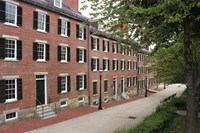- Manhattan Project National Historical Park (131)
- Boston National Historical Park (82)
- Golden Gate National Recreation Area (73)
- Lewis & Clark National Historic Trail (66)
- Acadia National Park (52)
- Yellowstone National Park (45)
- Allegheny Portage Railroad National Historic Site (42)
- Lowell National Historical Park (42)
- Grand Canyon National Park (41)
- Show More ...
- National Center for Preservation Technology and Training (57)
- National Heritage Areas Program (45)
- National Register of Historic Places Program (34)
- Denver Service Center (32)
- National Historic Landmarks Program (32)
- Harpers Ferry Center (30)
- Wildland Fire Program (30)
- Archeology Program (29)
- Geologic Resources Division (26)
- Show More ...
Showing 2,971 results for skilled workers ...
Susquehanna Museum at the Lock House
- Type: Place

Explore the Lock House Museum, a historic gem on the National Register of Historic Places, where the Susquehanna & Tidewater Canal’s story unfolds. Discover exhibits, including a working lock model and period-furnished rooms that bring 19th-century life to life. Step outside to walk the scenic Joe K Trail or cross the replica swing bridge, connecting you to the beautiful waterfront. Visit today and uncover the rich heritage of the Chesapeake Bay region.
Commissary
Otero Cabin
- Type: Place

The Otero (Cupit) Cabin is the oldest standing log structure in the park, built back in 1915. The Oteros, who owned the land from 1899 to 1918, grazed sheep on the mountains and cattle and horses in the valleys. Frederico Otero lived there until 1917, but later occupants included staff working seasonally on the ranch. Names carved over the door frame include Danny, Shawn, and Nathan Cupit and are dated 1967 and 1977.
- Type: Article

By using the expertise of a MAT team, Palo Alto Battlefield National Historical Park maximized the impact of GAOA funding, demonstrating how specialized teams efficiently address critical needs in parks across the country. Learn how Palo Alto Battlefield stands ready to continue sharing its stories of courage and sacrifice, thanks to this vital project.
Oak Ridge Wayside: Middletown Trailer Park
Oak Ridge Wayside: The Hutments
- Type: Article

César E. Chávez National Monument is undergoing significant rehabilitation work made possible by several funding sources including the Great American Outdoors Act (GAOA). The project addresses deferred maintenance, such as replacing the irrigation system, repairing cracked and missing stucco surfaces of site walls and columns, and painting all site walls and columns. and more.
- Type: Article

The LeChee Chapter House hires teens and offers them a variety of placements in the community, such as Glen Canyon, where the youth can gain real world job skills and new experiences. Ketona Reed has been a member of this youth partnership program between Glen Canyon National Recreation Area and the local LeChee Chapter House of the Navajo Nation for three years.
Old Faithful Inn
Oak Ridge Wayside: Edgemoor Gate
Oak Ridge Wayside: Oak Ridge Bombers
Moses Cone
Patrick J Mogan Cultural Center
- Type: Place

Greenwich Village Historic District’s reputation for dynamism can be attributed to its history of emerging artists and writers as well as the political unrest and activism of its inhabitants. With the rise of the counterculture movement during the 1960s, Greenwich Village’s Washington Square Park became a hub for writers and musicians. In 1969, LGB residents of Greenwich Village pushed back against police harassment at the Stonewall Inn.
- Type: Article

Since the early 2000s, ecologists who monitor rocky intertidal ecosystems each year have noted declines in a key intertidal seaweed commonly called rockweed. Rockweed is considered a foundational species, meaning that its presence is so important that without it the entire ecosystem would change radically. At Channel Islands National Park, marine ecologists are working with local scientists to understand the best methods to restore rockweed.
Marching for Justice in the Fields
- Type: Article

The farm workers who marched from Delano to Sacramento represented the large, seasonal labor force, composed overwhelmingly of people of color, whose labor made California’s thriving agricultural industry possible. Although their labor produced fortunes from the soil, they were subjected to poor wages and working conditions. This article is an introduction to the issues that motivated the Delano Grape Strike and the 1966 march.
Thirty Years of Farmworker Struggle
- Type: Article

Labor organizing has a long history in agriculture. Between 1930 and 1960, diverse groups of farmworkers in California struggled to form unions and to take collective action for better wages and working conditions. This article highlights the political and legal structures that made organizing in the fields especially difficult.











